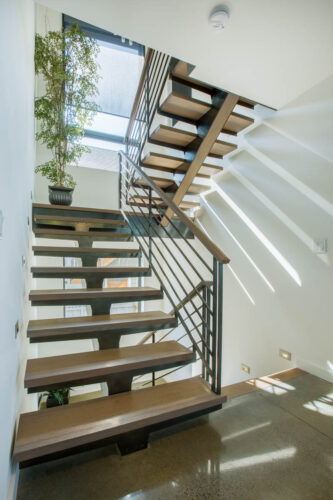
Stair Design 101
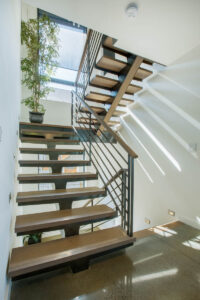
Whether you’re building new, adding on, or remodeling a multistory home there’s one element that can have a major impact on your space planning: stairs. With so many options on layouts and styles, this guide will help you get started on thinking about your stairs.
Under most circumstances (and in most jurisdictions under the current code) there are a few basic requirements to keep in mind when planning for a new stair in a residential project.
- Must be at least 36” wide.
- Cannot have a riser higher than 7 ¾” (residential)
- The landing at the top and bottom of the stair must at minimum be as wide as the stair and the depth to match the stair width.
- Must have minimum 6’-8” clear head space between nose of riser and ceiling/finish above.
- There are a few exceptions for the above for stairs leading to attics and small lofts.
Step 1: Stair Shapes
There are many different types of stairs with unique space considerations and dimensions to keep in mind.
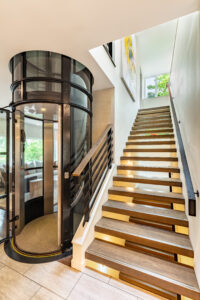
© Nathaniel Willson 2018. All rights reserved.
Straight Run: The most common stair type, this stair goes in one straight line typically without any landings other than the top and bottom. Straight run stairs are a great fit for narrower spaces with a lot of length to work with.
L-Shape: Much like the name indicates this stair has a landing somewhere in the run with a 90 degree turn. L-Shape stairs are great for small spaces as they can be tucked into a corner and leave a good amount of usable floor space.
U-Shape: This stair is similar to the L-Shape but has a 180 degree turn at the landing. This stair is ideal for wider more generous spaces since they tend to take up more floor area than the other shapes.
Spiral: A helical/circular stair more commonly used as an accent stair or in very small spaces. These stairs can have a great visual impact to a space but tend to be less safe than the other shapes and not recommended for areas with a lot of foot traffic.
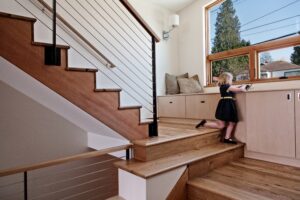 Step 2: Open vs. Closed
Step 2: Open vs. Closed
It seems like a simple question, but there are pros and cons to having an open (railings on the sides so you can see into the adjacent spaces) or closed (walls on all sides) staircase. Here is a brief list of pros/cons:
Open Stair pros:
- Visibility and connection into the spaces around the stairs
- Opportunity to introduce railing or slat wall design into the space
- Makes the stair an architectural feature of the space
Open Stair cons:
- The biggest con for an open stair is sound travelling between floors and spaces.
- Open stairs are typically more expensive than closed stairs
Closed stair pros:
- Keeps noise from travelling between floors and spaces
- Allows opportunity for doors at the top/bottom of the stair to add more security and sound dampening
- Typically less expensive than open stairs
Closed stair cons:
- No visual connection between floors and spaces
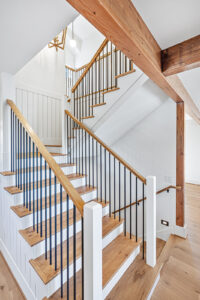 Step 2: Stair Construction
Step 2: Stair Construction
The construction type of your stair can significantly change the look and style of your space, but it also has the most impact on the cost of your stair. While there are some up-charges to go from a straight run to a spiral stair shape, the construction type will be a major factor when it comes to budget. Here are just a few examples of construction types:
Standard wood frame closed riser ($): This is the most common stair construction type. It’s the least expensive and does not require specialty engineering or construction. These stairs can be open or closed and finished with a variety of materials such as carpet or hardwood.
Open riser with closed end ($$): An almost middle-ground between a floating stair and a closed riser stair, this option has “floating” treads between two stringers or walls. The stringers or sides of the stair can be wood or metal and will require some additional engineering.
Steel stringer floating tread ($$$): One of the most desired modern stair designs we see requested by clients this stair has a single steel beam in the middle with “floating” treads. These stairs are a great feature for spaces but come at a high price and require specialty engineering and construction.
Cantilever stair ($$$$): These stairs appear to “float” off the wall with only one side having a hidden connection point. They require meticulous engineering to ensure there isn’t too much flexibility on the ends furthest from the walls.
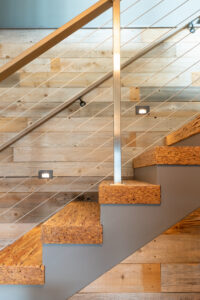 There are a lot of other factors that go into designing the perfect stair for your home. Stay tuned for more blog posts getting into the fine details of stair design coming soon!
There are a lot of other factors that go into designing the perfect stair for your home. Stay tuned for more blog posts getting into the fine details of stair design coming soon!

